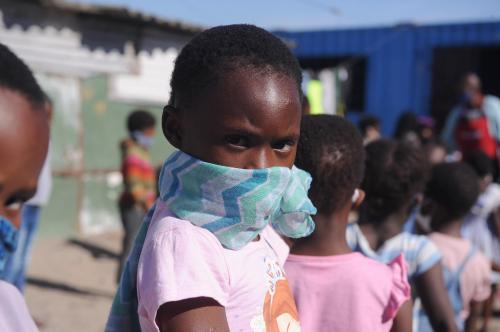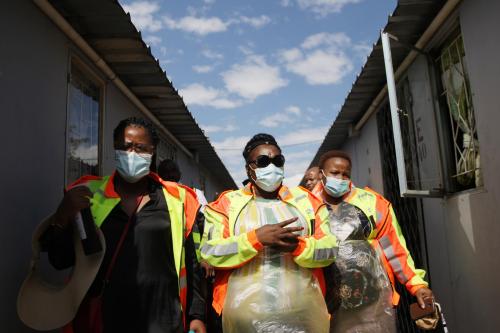Women and girls in Africa are among the most vulnerable groups exposed to the negative impacts of the coronavirus pandemic. Although preliminary evidence from China, Italy, and New York shows that men are at higher risk of contraction and death from the disease—more than 58 percent of COVID-19 patients were men, and they had an over 60 percent higher rate of fatality over women—certain preexisting socioeconomic conditions of women make them more exposed to the indirect consequences of the pandemic, requiring specific policy responses to mitigate their plight.
African women are at the front lines
First, women in Africa are overrepresented at the front lines of the response to the pandemic—meaning women, as direct caregivers, are more directly exposed to the virus. Over 60 percent of Africa’s health workforce and essential social service providers are female, even as high as 91 percent in Egypt. Second, back at home, women shoulder far more care work than men—up to 11 times more in places like Mali. Additional care needs from school closures as a result of the lockdowns and elderly relatives who need to be specially taken care of mean that women have to provide even more care services at home while still working, mainly because of entrenched traditional norms on gender roles in many African countries. The extra care work at home from the lockdowns is estimated at around 4 hours per day.
African women in the labor force are more vulnerable to income and job loss
Compounding these difficulties, women are at a higher risk of job and income losses during the pandemic: Evidence from the Ebola outbreak in West Africa in 2014 shows that women suffered more economic losses as a result of that crisis. Similarly, the coronavirus pandemic primarily affects the types of jobs often done by women in service sectors such as air travel, hospitality, tourism, food and beverage, and retail services in general. The impact of border closures and lockdowns on industries along the supply chain are further exposing women to income losses, especially in countries integrated into global value chains, such as light manufacturing in Ethiopia where more than 50 percent of textile workers are women—who are also reputed to be the lowest-paid garment factory workers around the world. Furthermore, women’s generally weaker positions in the labor market—for example, with lower earnings and less seniority than men as well as higher informality in their work (89 percent of women in Africa are employed informally) with no employment security and benefits—leaves them more vulnerable and easier to lay off by employers than men in the wake of COVID-19.
Reports of domestic violence are on the rise
A further distressing challenge facing women during the pandemic is that the risk of intimate partner violence, sexual harassment, and abuse of women and girls is exacerbated under lockdowns. Indeed, Google searches for domestic violence indicate a spike in the number of people searching for help dealing with domestic violence and sexual harassment in Africa since the start of COVID-19 (Figure 1). In Kenya, for instance, calls for help against domestic violence have increased by 34 percent in the first three weeks of the 7 p.m.-5 a.m. curfew. Similar trends have been observed in developed and emerging market economies including the U.S, U.K., and China, prompting U.N. Secretary-General António Guterres to appeal in a recent tweet “for peace in homes around the world” and urging “governments to put women’s safety first as they respond to the pandemic.”
Figure 1. Google searches for ‘domestic violence help’ in selected countries since COVID-19
Source: Authors’ illustration using moving averages from Google Trends data.
Policy recommendations
Given these particular challenges, governments must, therefore, take bold steps to mainstream gender in their responses to the crisis. The first step is to identify and protect the lives of women who are trapped at home with their abusers. Reporting cases of violence should be made as easy and as safe as possible. Abusers often monitor or restrict access of victims to the outside world, so policymakers should devise innovative ways of receiving reports of violence during the pandemic such as specially dedicated hotlines, apps, and use of coded messages (one smart innovation used in Spain is for victims to use the code “Mask-19” at local pharmacies to discreetly signal their plight; similar strategies could be adapted in many African communities). Incentives for reporting—such as further protection and income support—could be provided to encourage victims to speak up. But prevention is better than a cure, so governments should scale up public awareness campaigns, particularly those targeted at men and boys, to discourage violence against women, warning of the punitive consequences.
For women working as first responders and in other essential services, governments should promote and accommodate flexible working arrangements that account for workers’ family responsibilities. Because women more often work in economic sectors that are hardest hit, they require specific financial assistance to maintain their living standards through one-off income support in cash and/or in-kind such as suspension of rent and utility payments. These policies would help affected women and girls stay afloat in their homes (avoiding evictions) and continue to support their families.
Gender-targeted fiscal stimulus packages could be implemented through gender budgeting, with every disbursement done with a gender lens to address the effects of the pandemic on women. Financial lifelines to vulnerable small and medium-sized enterprises should be targeted at women business owners and, for vulnerable households, the money should be put in the hands of women to ensure more effective use, as past research has shown. In addition, more funding should be provided to women’s rights groups that work in communities to support women and girls during the crisis. These groups should be classified among essential service providers during the lockdowns.
To safeguard progress made toward achieving gender-related Sustainable Development Goals in Africa, the political will for gender mainstreaming in government’s response to COVID-19 must come from the highest levels to achieve a whole-of-government approach. New legislation to abolish discriminatory laws on women in the region must continue, and resources earmarked for gender-transformative policies pre-COVID-19 should not be diverted during the crisis but should be used to provide immediate relief for women.
African policymakers should act quickly and decisively to save the lives and livelihoods of African women and girls amid COVID-19.
The Brookings Institution is committed to quality, independence, and impact.
We are supported by a diverse array of funders. In line with our values and policies, each Brookings publication represents the sole views of its author(s).










Commentary
Putting women and girls’ safety first in Africa’s response to COVID-19
May 8, 2020